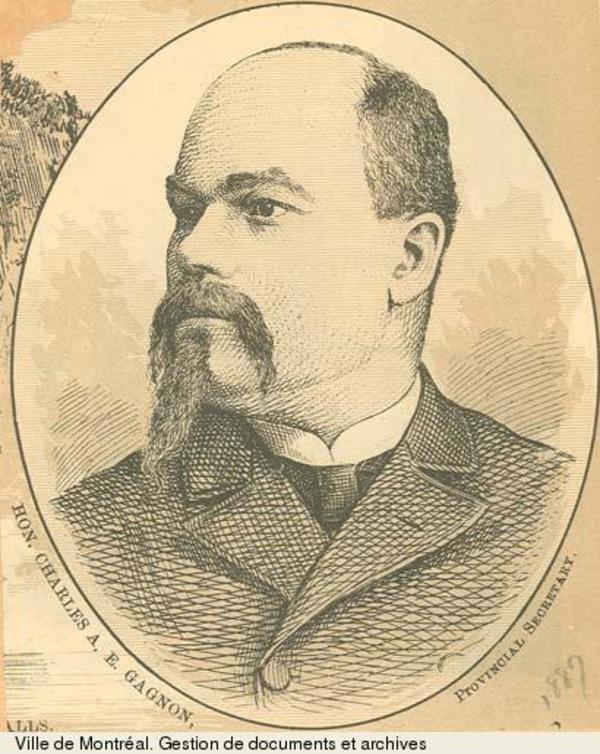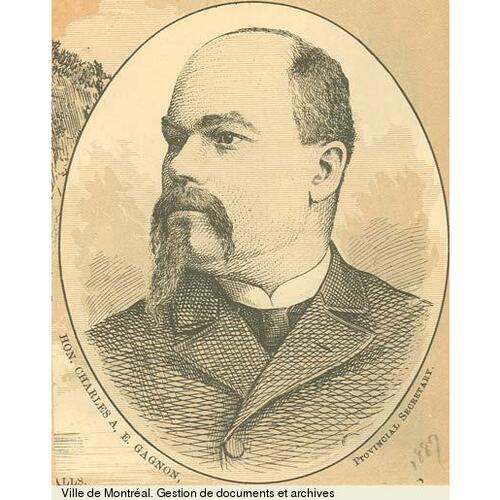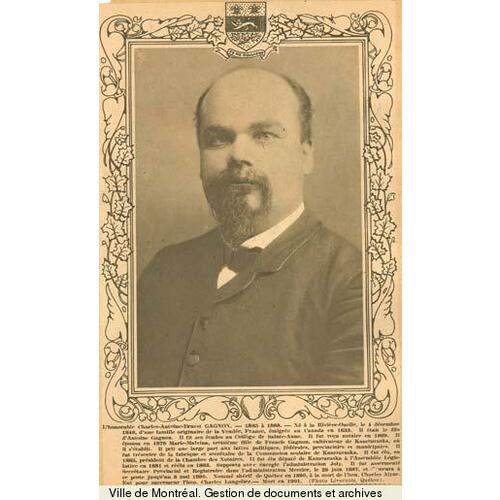
Source: Link
GAGNON, CHARLES-ANTOINE-ERNEST, notary, politician, author, and office holder; b. 4 Dec. 1846 in Rivière-Ouelle, Lower Canada, son of Antoine Gagnon, a merchant, and Julie-Adèle Pelletier, sister of Charles-Alphonse-Pantaléon Pelletier*; m. 14 June 1870 Marie-Malvina Gagnon in the parish of Notre-Dame-de-Liesse at Rivière-Ouelle, and they had five daughters and three sons; d. suddenly 11 June 1901 at Quebec and was buried 14 June in the Rivière-Ouelle cemetery.
Charles-Antoine-Ernest Gagnon was born into one of the oldest families in the province of Quebec. He spent his childhood in Rivière-Ouelle and did his classical studies at the Collège de Sainte-Anne-de-la-Pocatière from 1859 to 1863. Accepted as a student for the notarial profession the following year, he obtained his licence in 1869 and settled in his native parish. In addition to practising as a notary, he held the offices of secretary-treasurer to the municipal council and the school board and treasurer of the fabrique. From 1873 to 1878 he was a land appraiser for the Intercolonial Railway and from June 1874 to March 1878 he served as receiver of wrecks. He was also chairman of the bankruptcy board of the Stadacona Fire and Life Insurance Company.
Politically, Gagnon followed in the footsteps of Lieutenant Governor Luc Letellier* de Saint-Just, who was also from Rivière-Ouelle. In the provincial election of 1878 he won the seat for Kamouraska as a Liberal, but by just 25 votes. The Liberal party managed to remain in power only with great difficulty. After the removal of Letellier de Saint-Just from office in July 1879 and the defeat of the government of Henri-Gustave Joly in October, Gagnon found himself sitting in the opposition.
From then on, Gagnon was a bitter adversary and fierce critic of the ruling Conservatives. He also tirelessly defended the honour of the Joly government and of Letellier de Saint-Just, for whom he continued to express the greatest admiration. In July 1880 he and other Liberals founded the Quebec daily L’Électeur as a party organ. Until late the next year he served as manager of the paper’s publishing company, with Ernest Pacaud as editor-in-chief. The appearance in April 1881 of an unsigned article entitled “La caverne des 40 voleurs” that took aim at Louis-Adélard Senécal*, a financier with Conservative connections, led to Gagnon’s arrest for libel. Released pending his trial, he became the unwilling subject of a political and judicial controversy which ended, for him, when Wilfrid Laurier* confessed to being the author of the offending piece.
Undaunted by this affair, Gagnon pursued his political career, running again in his riding in the general election of November 1881. This time he won by a single vote, and the results were overturned by the courts in January 1883. However, in the by-election at the end of that month Gagnon had a majority of 61. In the general election of October 1886 he was re-elected by 63 votes.
In the Legislative Assembly, Gagnon defended the interests of his riding and the measures he thought necessary for the smooth functioning of the political and judicial systems. The most effective of his many speeches in the house were the one in favour of rebuilding the Kamouraska court-house, which had been destroyed by fire, and the one opposing transfer of the seat of the judicial district to the neighbouring riding of Témiscouata. Though he admitted he was “not a financier,” he also devoted considerable attention to the expenses of public administration, badgering the ministers with questions, especially on the cost of education, colonization, and railways, including the Quebec, Montreal, Ottawa and Occidental, of which Senécal was a director. Gagnon’s speeches bore the stamp of his training in law and his interest in his profession. Skilled in matters of procedure, he took an active part in debates about the administration of justice and about reform of the electoral law, the civil code, the municipal code, laws governing the notarial profession, and the rules of the house. He was also a member of the Quebec Board of Notaries and served as its president from 1885 to 1890.
With the fall of the Conservative government in January 1887 [see John Jones Ross; Sir Louis-Olivier Taillon*], the Parti National under Honoré Mercier* came to power and new prospects opened up for Gagnon. On 29 January he was appointed to the Mercier cabinet as provincial secretary and registrar. Obliged to resign his seat and seek re-election, he was returned by acclamation for Kamouraska two weeks later. He assumed responsibility for industrial and reform schools, public health, charitable institutions, and the queen’s printer. He remained in the cabinet little more than three years, not long enough to achieve any major accomplishments. However, his name is associated with two measures: an act passed in 1889 to depoliticize the civil service by depriving provincial employees of the right to vote, and another, passed in March that year, guaranteeing that contracts made with owners of asylums would be respected, notwithstanding the law passed by the Ross government four years earlier, which provided for the supervision of such institutions by members of the medical profession.
Blunt, quick to react, straightforward, and seldom diplomatic, Gagnon was feared and detested to an unusual degree by his political opponents, who, according to Robert Rumilly*, said he was “past praying for.” After his appointment to the cabinet, his temperament proved rather ill-suited to his new duties, contrasting markedly with Mercier’s moderation. The Conservative opposition were quick to describe him as “uncouth.” Uncomfortable in a setting that prevented him from showing his true worth, he found consolation in history, literature, and the arts. For example, as secretary and registrar he won the praise of the intellectual élite by arranging for the publication of a number of archival documents, including the Collection des manuscrits du maréchal de Lévis, edited by Henri-Raymond Casgrain. He contributed in his own right to several magazines and newspapers, amongst them the Bibliothèque internationale de l’Alliance scientifique universelle, tome 1, fascicule 3, prepared by the Quebec committee (1892), and the academic honour of officier d’académie was bestowed on him by the French government.
On 9 May 1890 Gagnon resigned and was appointed sheriff of the district of Quebec, an office he retained for the rest of his life. Although a good many of his constituents in Kamouraska remained faithful to him, convinced he had resigned under pressure and hoping he would continue his political career as an independent, the opposition could hardly conceal its elation.
As a notary interested in public life, Gagnon always declared himself a Liberal. He proved a faithful and valuable lieutenant who never hesitated to defend the interests of the party, its policies, supporters, and leader. Although some may have seen leadership qualities in him, Gagnon was a potential source of embarrassment and he remained a second-rank politician, undeniably useful for his enthusiasm and his professional competencies.
AC, Kamouraska (Rivière-du-Loup), État civil, Catholiques, Notre-Dame-de-Liesse (Rivière-Ouelle), 14 juin 1900. ANQ-BSLGIM, CE4-1, 5 déc. 1846, 14 juin 1870; E4; E17; P-88. Bibliothèque de l’Assemblée Nationale (Québec), Div. de la recherche, dossiers des parlementaires. L’Électeur, avril–novembre 1881, esp. 27 avril, 14 nov. Cyclopædia of Canadian biog. (Rose and Charlesworth). Index général des “Journaux” de l’Assemblée législative de la province de Québec . . . , Louis Fortier, compil. (Québec, 1893). Qué., Assemblée Législative, Débats, 1879–90. J.-E. Roy, “L’honorable C.-A.-E. Gagnon, président de la Chambre des notaires (1885–1890),” La Rev. du notariat (Lévis, Qué.), 3 (1900–1): 329–35, 357–62. P.-G. Roy, “Les shérifs de Québec,” BRH, 40 (1934): 441–43. RPQ. Rumilly, Mercier et son temps.
Cite This Article
Richard Lapointe, “GAGNON, CHARLES-ANTOINE-ERNEST,” in Dictionary of Canadian Biography, vol. 13, University of Toronto/Université Laval, 2003–, accessed April 18, 2025, https://www.biographi.ca/en/bio/gagnon_charles_antoine_ernest_13E.html.
The citation above shows the format for footnotes and endnotes according to the Chicago manual of style (16th edition). Information to be used in other citation formats:
| Permalink: | https://www.biographi.ca/en/bio/gagnon_charles_antoine_ernest_13E.html |
| Author of Article: | Richard Lapointe |
| Title of Article: | GAGNON, CHARLES-ANTOINE-ERNEST |
| Publication Name: | Dictionary of Canadian Biography, vol. 13 |
| Publisher: | University of Toronto/Université Laval |
| Year of revision: | 1994 |
| Access Date: | April 18, 2025 |





